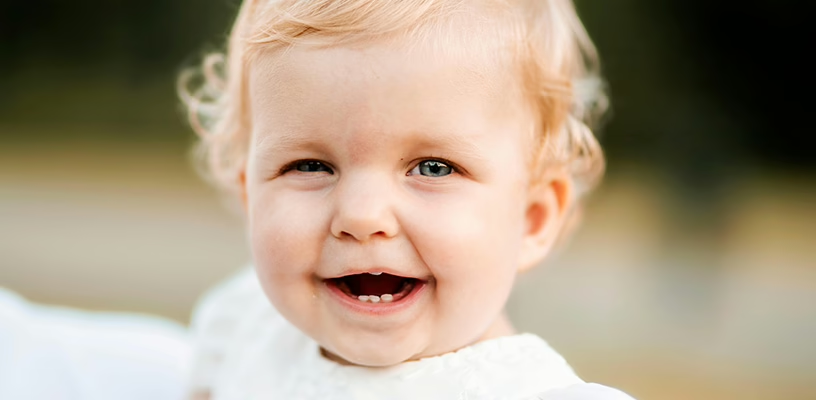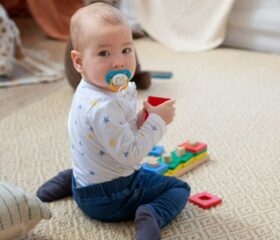When Do Babies Start Teething and How Can You Help?
It's finally here: the dreaded moment when those gummy grins turn into tests of your patience.

Surviving your baby’s teething stage is a rite of passage for every parent. His first tooth will be a celebrated milestone … if you can make it through the fussiness, drooling, and disrupted sleep, that is.
Let’s take a look at when teething typically happens, when to get help from your doctor, and how to ease your baby’s discomfort.
When do babies start teething?
No two babies are alike (which certainly keeps things interesting). Some overachievers start teething as early as 3 months old, but you’ll typically see that first tooth appear when your baby is between 4 months and 7 months old. 1
While there’s no set timeline, most children have all their baby teeth (also known as milk or deciduous teeth) by the time they’re 3 years old. 2
What if your baby starts teething later than usual?
If your baby’s teeth are taking their sweet time coming in, this is referred to as a delayed eruption. Although it can be stressful if your child isn’t developing at the same rate as everyone else, many factors beyond your control determine when your baby’s teeth will finally come through: 3 4 5
- Premature birth: If your baby was born early, he may face a multitude of complications with his health that delay certain development milestones.
- Genetics: Just like his eye color or height, the timing of your baby’s teething is at least partially hereditary. If you or your partner were early or late teethers (or you have a family history of it), your baby might follow in your footsteps.
- Nutritional deficiencies: If your baby’s not getting enough vitamins and minerals (specifically, vitamins A, C, D, and calcium), it can impact the timing of his tooth eruptions. These nutrients are important for developing the bone structure needed for your baby’s teeth to emerge. Talk to your pediatrician about what foods to include in your baby’s diet to ensure balanced, nutritional meals.
- Development disorders: Some genetic conditions increase your baby’s risk of delayed tooth eruptions, such as SHORT syndrome. That stands for “short stature, hyperextensibility of joints, ocular depression or deep-set eyes, Rieger anomaly (a defective development of the eye that often results in glaucoma), and teething delay.” 6
If your baby hasn’t had any teeth come through by his first birthday, take him to a pediatric dentist. 4 We’ll cover the warning signs that something might actually be wrong in more detail below, but past that point, it becomes more likely there’s an issue that’s significantly outside the norm (instead of just late teething being explainable by ordinary variation).
What are the signs of teething?
Although it’s difficult to say for sure what your baby’s symptoms will look like, teething is usually to blame if you notice any redness or swelling along the gumline.
In particular, if you spot a bluish lump in the gums (often called an eruption hematoma or gum hematoma), this is a benign sign of a growing tooth that is soon to erupt. 7
Here are some other common signs of teething to look out for: 8
- Chewing and biting: Beware of the mouthing monster. Sometimes, the only way for your baby to relieve the pressure of new teeth pushing up under his gums is to latch on to anything and everything he can fit in his mouth—including his own hands.
- Elevated body temperature: Your baby may develop a higher temperature (between 98 °F and 100 °F) due to a new germ being introduced from mouthing. If the temperature is 100.4 °F or higher, please talk with your pediatrician or get immediate care.
- Drooling and mild rashes: Speaking of slobber, your baby might start drooling a lot. The enzymes in his saliva can be irritating to the skin around his mouth, cheeks, chin, and neck, often causing him to get rashes in those areas if it’s left for long enough.
- Coughing or gagging: That excess saliva may sometimes cause your baby to choke or gag on his spit every once in a while. This usually isn’t anything to worry about, so long as he doesn’t have any other cold or flu symptoms, like a high fever.
- Fussiness and irritability: Understandably, your baby might be a little cranky while dealing with the discomfort of his teeth erupting for the first time—especially when his molars (the largest teeth) start crowning.
Since your baby’s gums are extra sensitive, his appetite may decrease, as eating could exacerbate the pain. He might also find it more difficult to sleep through the night because of the discomfort.
Of course, just like adults, all babies tolerate pain and discomfort differently. During teething, some are stone-faced, while others need a little more help getting by.
When to call the doctor about your baby’s teething
While most teething symptoms are harmless, others can indicate serious underlying conditions. You should contact your pediatrician if your baby has the following symptoms:
Ear pulling or cheek rubbing
Since the nerves in the gums, ears, and cheeks are interconnected, your baby may tug at his ears or rub his cheeks when he’s teething. However, this is also a possible sign of an ear infection if it persists or gets paired with a fever. 8 9
A high fever
As mentioned, a slightly elevated body temperature (98°F–100°F) might be nothing to worry about, but if your baby’s temperature exceeds 100 °F (especially if he’s under 3 months old), get him to your pediatrician straight away. 10
False teething symptoms
Your baby will likely start to lose the antibodies you passed on to him around the same time he begins teething, so he might get sick more often. 11
Some symptoms can occur because of teething but should prompt you to consult your baby’s healthcare providers if they persist or seem abnormal. The symptoms to be cautious about include: 12
- Excessive crying
- Diarrhea
- Diaper rash
- A runny nose
What are some effective methods for soothing your teething baby?
No parent wants to see their baby suffer, but it’s important to choose safe and effective ways (rather than the quickest ways) to help him through this painful stage. Here are some effective ways to relieve your baby’s pain:
Gum massage
If your baby’s gums are sore, soothe the pain by gently massaging them, especially in the affected areas.
Use a clean finger or grab a damp gauze pad to softly knead your baby’s gums, providing counter-pressure as you move your fingers in small circles. You can do this for about 2 minutes at a time. 13
Teething toys
Your baby may want to grab the closest thing on site to chew on, like furniture and phone cords. Obviously, that isn’t ideal. Instead, provide safe and sturdy options like silicone or rubber teething toys with different textures to soothe his sore gums.
Ideally, these should be easy for your baby to grip and even easier for you to wash. 13
Use safe and non-toxic teething toys
Choose your baby’s teething toys carefully. When buying one, ensure that it’s made of non-toxic, BPA-free materials. You should also carefully inspect the toy to make sure there are no small parts that can get dislodged and become choking hazards. 14
Cold relief
If you’ve ever used a cold compress, you know they’re perfect for numbing pain and reducing inflammation. You can use these cold items to treat your baby’s discomfort, but avoid freezing them as this can be too harsh on his gums:
- Refrigerated teethers: You’ll want to keep your fridge stocked with a steady supply of clean teething toys. Remember to clean them after each use.
- Cold washcloth: A clean, damp washcloth chilled in the fridge is a simple but effective way to provide your baby with some relief. Preferably, you’ll want to pick a washcloth that’s soft and not too irritating on the gums. It’s also best to supervise your baby so he doesn’t choke on the washcloth.
- Cold foods: If your baby’s already eating solid foods, you can experiment with chilled pureed fruits, vegetables, or yogurt to see if that helps. A chilled banana is a good choice if your baby is over 12 months old. 15 You need to monitor him to ensure he doesn’t eat too much too quickly or have allergic reactions.
If you give your child food that’s been frozen (not just chilled), let it thaw first. Completely frozen items can be too hard on your baby’s gums.
Sucking
Your baby might find comfort in sucking, so giving him a chilled pacifier can relieve the pain. Naturally, you can also offer a bottle or a breastfeeding session if it’s around feeding time and you think it might help.
Pain relievers
You should always talk to your pediatrician before you give your baby any over-the-counter (OTC) pain relievers.
With that being said, the most common types of OTC medicine for babies are acetaminophen (used in Tylenol) for newborns and up, or ibuprofen (found in Motrin or Advil) for those 6 months old and up. 16
Extra snuggles and comfort
Sometimes, your baby just needs a hug from his mama. A little extra love can go a long way when he’s feeling frustrated and uncomfortable.
You can offer a sense of security to your baby by holding him, cuddling him, or engaging him in play with his favorite toy.
What soothing methods should you avoid?
While you may be tempted to try anything to ease your baby’s pain, the FDA recommends avoiding certain remedies:
- Numbing medications: Avoid over-the-counter numbing gels, creams, and tablets, especially those containing benzocaine or lidocaine, as they can cause serious side effects in babies, such as reduced oxygen levels in the blood, heart problems, brain injury, and even death. 17
- Homeopathic teething tablets and gels: Remedies that include the ingredient belladonna have been linked to reports of seizures in babies and children. 18
- Teething necklaces: Skip any anti-teething jewelry, as it can pose choking and strangulation hazards for your baby. 19
In addition, you should never consider the following:
- Liquid-filled teething toys: Old teething rings or those manufactured outside the US may contain liquid that is contaminated with bacteria. 20 If your baby is teething on one of these toys, his developing teeth could puncture the ring, causing the liquid to spill out or leak over time.
- Aspirin: You should never give aspirin to babies or children due to the risk of Reye’s syndrome, a rare but dangerous condition that can cause liver damage and brain swelling. 21
- Gum cutting: In some cultures, cutting the gum (sometimes called gum-lancing) is a well-meaning practice done to help alleviate the baby’s pain and free the tooth. However, cuts in the gums can lead to complications like infections. 22
If you give your baby medicine, you should always follow the dosing instructions carefully so that you know how much medicine to give your baby (and how often) to give it.
Which teeth come first?
While each baby is unique, the eruption of your baby’s teeth will probably follow a set pattern: 23
- 5 months to 7 months old: The first two teeth to appear are usually the bottom front ones (central lower incisors)
- 6 months to 10 months old: The next are the two top front teeth (central upper incisors), followed by the teeth on either side of the lower incisors (lateral lower incisors).
- 8 months to 12 months old: The teeth next to the upper front incisors are the next ones to pop up (lateral upper incisors).
- 13 months–19 months old: The first molars (usually the sixth teeth from the midline of your mouth) come in your baby’s upper and lower jaws.
- 16 months–23 months old: The pointy teeth (canines) appear on either side of the lateral incisors in the upper and lower jaw.
- 23 months–33 months old: Finally, the second molars (in the very back of the mouth) erupt in the upper and lower jaws, completing your baby’s set of 20 primary (milk) teeth.
If that seems like fewer teeth than you can count in your own mouth, you’re right. While adults generally have 32 teeth, babies don’t have enough room (or need) for the premolars or third molars (wisdom teeth) used for grinding harder food.
How to care for your baby’s new teeth
Although your baby’s new set of teeth isn’t permanent, it’s still important to care for them. In fact, even before you see your baby’s first tooth, you need to take care of your baby’s gums.
After every feeding, you can use a wet gauze or washcloth to wipe off bits of food from his gums to keep them clean.
Once your baby’s teeth emerge, switch to an infant toothbrush with soft bristles that suit your baby’s tender gums and enamel. Use a small dab of dentist-recommended fluoride toothpaste (about the size of a grain of rice) until your child is about 3 years old. Then, you can add more toothpaste (about the size of a pea). 24
It’s generally recommended to take your child to a pediatric dentist around his first birthday or within 6 months of his first tooth eruption, whichever comes first. 25
These early dental visits are important to establish good oral hygiene habits and expectations for you and your baby and help you catch any potential issues early on.
Final thoughts
Just to reiterate, teething is a natural part of your baby’s development, usually starting between the fourth and seventh months. It can cause drooling, irritability, and sleeping difficulties—but although this stage can be trying for both you and your child, it’ll pass.
Be patient. Soon enough, you’ll be emptying out your pockets in preparation for the tooth fairy’s first visits!
Article Sources
- Nemours KidsHealth. "Teething Tots" Retrieved August 26, 2025.
- New York State Department of Health. "Infant and Children's Oral Health" Retrieved August 26, 2025.
- StatPearls. "Anatomy, Head and Neck, Tooth Eruption" Retrieved August 26, 2025.
- World of Dentistry. "Teeth Development In Children: 6 Signs And Symptoms Of Teething" Retrieved August 26, 2025.
- TrueCare. "Baby Teeth Coming in Late: When is it a Cause for Concern?" Retrieved August 26, 2025.
- National Organization for Rare Disorders. "SHORT Syndrome" Retrieved August 26, 2025.
- The University of Washington Center for Pediatric Dentistry. "Oral Health for Infants and Toddlers" Retrieved August 26, 2025.
- Children’s Hospital Los Angeles. "Your Infant is Teething: Know the Signs and Symptoms" Retrieved August 26, 2025.
- Seattle Children’s Hospital. "Ear - Pulling At or Rubbing" Retrieved August 26, 2025.
- Boston Children’s Hospital. "Fever" Retrieved August 26, 2025.
- AMA Journal of Ethics. "Testing Newborns for HIV" Retrieved August 26, 2025.
- HealthyChildren.org. "Teething" Retrieved August 26, 2025.
- Post Road Pediatrics. "Teething" Retrieved August 26, 2025.
- Center for Environmental Health. "9 Non-Toxic Teethers" Retrieved August 26, 2025.
- Seattle Children’s Hospital. "Teething" Retrieved August 26, 2025.
- University of Rochester Medical Center. "Over-The-Counter (OTC) Medicines for Babies and Children" Retrieved August 26, 2025.
- U.S. Food and Drug Administration. "Safely Soothing Teething Pain in Infants and Children" Retrieved August 26, 2025.
- U.S. Food and Drug Administration. "FDA warns against the use of homeopathic teething tablets and gels (retrieved from archive.org)" Retrieved August 26, 2025.
- U.S. Food and Drug Administration. "FDA warns about safety risks of teething necklaces, bracelets to relieve teething pain or to provide sensory stimulation (retrieved from archive.org)" Retrieved August 26, 2025.
- Missouri Poison Center. "Teething Rings" Retrieved August 26, 2025.
- Stanford Medicine Children’s Health. "Reye Syndrome in Children" Retrieved August 26, 2025.
- Healthline. "How to Identify and Treat a Cut on the Gums" Retrieved August 26, 2025.
- Cleveland Clinic. "Teething/Teething Syndrome" Retrieved August 26, 2025.
- Stanford Medicine Children’s Health. "Brushing and Toothpaste for Children" Retrieved August 26, 2025.
- New York State Department of Health. "Oral Health for Infants and Children" Retrieved August 26, 2025.







